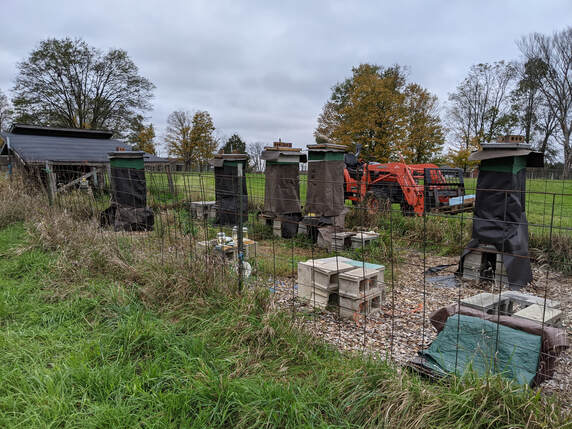 Advance Preparing a hive for winter starts in July with ensuring your bees are healthy (i.e. Varroa mite levels are under control), have ample resources (i.e. honey stores) to last them through the winter, and are queenright and strong (i.e. much easier to for 1 strong, large hive to survive winter than 2 small, weak hives). This means that you may have to feed your hives 2:1 sugar syrup (2 parts sugar to 1 part water) to bulk up their honey stores, and combine weak hives (particularly ones that are queenless, with queenright hives). Many beekeepers will typically also add a windbreak to their apiary in the winter. Common windbreaks include tarps, hay bales, and burlap. Bluster In addition to preparing your bees for winter, many beekeepers in colder climates also choose to prepare their hives for winter to help their bees survive the cold, resourceless months. There are two schools of thought when it comes to this hive preparation: ventilation and insulation. If a beekeeper keeps bees in typical, thin-walled Langstroth hive boxes with an inner cover and telescoping outer cover, and does nothing to prepare the hive structure for winter, they may have moisture problems in the hive. The bees form a cluster during the winter which they keep warm by flexing their wing muscles. Heat and water vapor are generated in this process and will rise to the top of the hive where they will condense on the cold inner and outer covers. The water will then rain down on and chill the bees. Condensation Proponents of ventilating a hive solve this problem by adding a quilt box on top of the hive (under the covers) to trap moisture and an upper entrance to allow air flow to remove the moisture from the top of the hive. They also typically wrap their hives in thin, black tar paper (i.e. roofing felt) to take advantage of the rays of the winter sun to “heat” the hive. Advocates of insulating a hive in the winter argue that upper ventilation lets out all of the heat because in addition to water vapor, heat also rises. They prefer to not have a quilt box or upper entrance and instead wrap their hives in thick foam board wrapped in black plastic and especially add insulation to the top of their hives to prevent the condensation of water vapor over the bee cluster. More Information: Winter Preparation Bees: www.honeybeesuite.com/how-to-prepare-your-hives-for-winter/ Ventilation: https://www.honeybeesuite.com/how-to-wrap-a-hive/ Insulation: https://www.beeculture.com/winter-management/
0 Comments
Leave a Reply. |
AuthorJen Haeger is a new master beekeeper and board member of A2B2. Archives
August 2022
Categories
All
|


 RSS Feed
RSS Feed
